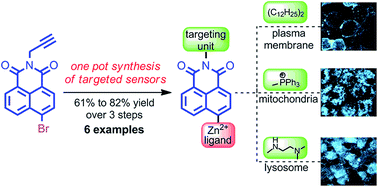Biologically targeted probes for Zn2+: a diversity oriented modular “click-SNAr-click” approach†
Abstract
We describe a one-pot strategy for the high yielding, operationally simple synthesis of fluorescent probes for Zn2+ that bear biological targeting groups and exemplify the utility of our method through the preparation of a small library of sensors. Investigation of the fluorescence behaviour of our library revealed that although all behaved as expected in MeCN, under biologically relevant conditions in HEPES buffer, a plasma membrane targeting sensor displayed a dramatic switch on response to excess Zn2+ as a result of aggregation phenomena. Excitingly, in cellulo studies in mouse pancreatic islets demonstrated that this readily available sensor was indeed localised to the exterior of the plasma membrane and clearly responded to the Zn2+ co-released when the pancreatic beta cells were stimulated to release insulin. Conversely, sensors that target intracellular compartments were unaffected. These results demonstrate that this sensor has the potential to allow the real time study of insulin release from living cells and exemplifies the utility of our simple synthetic approach.


 Please wait while we load your content...
Please wait while we load your content...